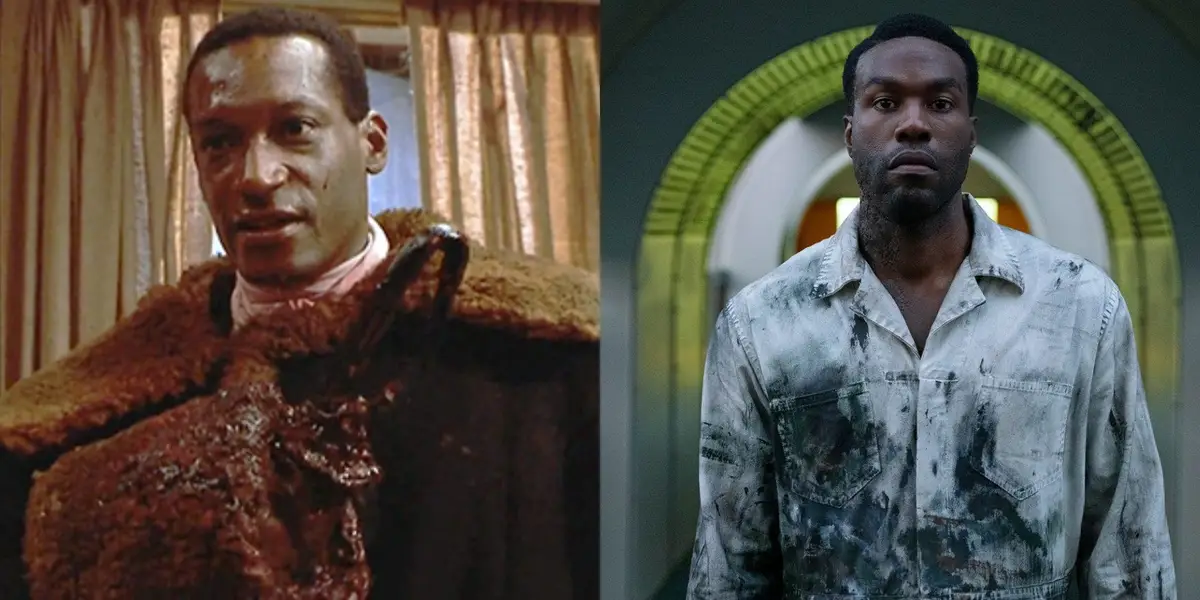
Horror Yearbook – Candyman has made a long-awaited return to cinemas. The 2021 film, directed by Nia DaCosta, is a sequel to the 1992 classic. It builds upon Clive Barker’s short story The Forbidden, originally set in Liverpool. The story is adapted to the housing projects of Chicago. Just like Barker’s tale, the movie mixes real urban legends with gripping horror themes. Candyman blends familiar myths with original storytelling, making it one of the most iconic characters in the genre. The character itself takes inspiration from legends like Bloody Mary and the Hookman, adding depth to the myth.
The Candyman character embodies various urban legends. One of his origins comes from Bloody Mary, a ghost summoned by repeating a phrase in front of a mirror. Another source is the Hookman, a hook-handed murderer. These two myths merge with elements from classics like Dracula. The films also incorporate stories like the razor blade in candy and the castrated boy. The razor blade myth is especially prevalent during Halloween. It remains a cautionary tale for parents. In fact, the original Candyman movie did an exceptional job of weaving these legends together.
The Candyman, in turn, has become an urban legend itself. Research into contemporary Bloody Mary versions has even incorporated Candyman’s name. People may fear Freddy Krueger or Jason Voorhees, but Candyman feels closer. He can come into your home if summoned. This direct connection between the legend and the viewer’s personal space is part of the appeal.
“Read about: This Child Remembers a Past Life with Shocking Detail!”
The original Candyman film presents a singular origin for the character. In the film, Candyman is the son of an enslaved Black man. He was murdered by a white mob for having a relationship with a wealthy white man’s daughter. This origin was crafted by Tony Todd, the actor who portrayed Candyman. However, the 2021 film presents multiple versions of Candyman’s tale. In one version, Candyman is a man killed by police after being falsely accused of tampering with candy. The retelling of the original story includes shadow puppetry by Manual Cinema, adding a unique artistic layer.
The presence of various versions reflects the nature of urban legends. They are rarely fixed. Different people, places, and times shape these tales. For example, Bloody Mary legends vary widely. In some cultures, the ghost is a young woman seeking revenge. In others, she is a mother who mourns the loss of her child. This adaptability is a key characteristic of urban legends, and it is also present in Candyman’s evolving myth.
“Read more: The Greatest Mistake John Hawkins Made and Lessons Learned”
The Bloody Mary story, like Candyman, is widely adaptable. The basic premise involves summoning a ghost by saying a phrase in front of a mirror. However, local variations emerge depending on geography and culture. In Tennessee, for instance, the Bell Witch may replace Bloody Mary in some versions of the legend. In the Latin world, La Llorona—the weeping woman—takes on the same supernatural role. These adaptations demonstrate how legends like Bloody Mary and Candyman resonate with specific local fears.
Why are urban legends so fascinating to us? Research indicates that certain types of stories are more likely to stick in our minds. Urban legends often evoke strong emotions, such as fear or disgust. This emotional impact is key to their longevity. Legends that involve social or survival threats tend to be more widespread. These tales help us navigate social dynamics and understand potential dangers.
The brain is wired to remember stories that provoke an emotional response. This may be due to our evolutionary need to track social relationships and identify risks. For instance, Candyman presents a clear threat: if you say his name five times, you will die. This simplicity and clarity make the myth particularly memorable. Furthermore, horror films like Candyman add an extra layer of fear and excitement. We anticipate the terror, which further fuels our fascination.
Urban legends also gain traction when they address relevant social issues. The latest Candyman film taps into contemporary concerns about racial violence. The film brings the historical violence of the original films into the present day. Issues like gentrification and police violence against Black individuals are central themes. These social topics resonate with modern audiences, making the legend feel even more urgent.
Research into how urban legends spread also suggests that social relevance is crucial. Social information often takes precedence over other forms of information. This explains why urban legends evolve to address current fears and anxieties. The Candyman myth, with its focus on racial injustice, connects deeply with today’s societal conversations.
Urban legends like Candyman endure because they address our primal fears and fascinations. They evolve over time, adapting to changing social contexts. And as long as these stories resonate with our emotions and concerns, they will remain irresistible.